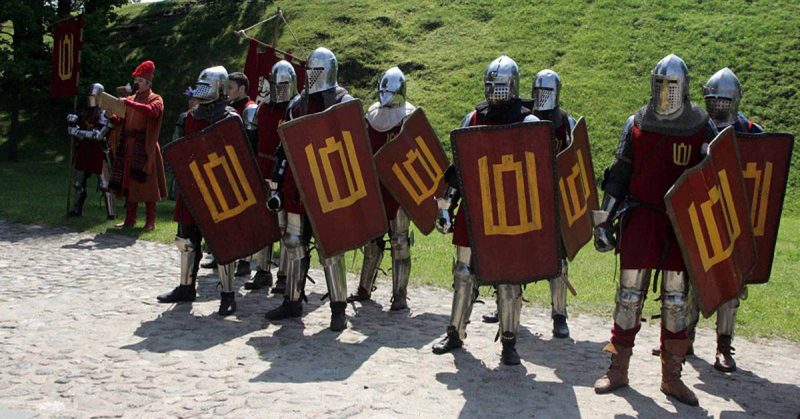The Crusades were monumental military efforts to secure Christian Holy lands around Jerusalem. Two orders of warrior monks, the Templars, and Hospitallers, had great successes in the Levant and surrounding areas, creating vast fortresses and aggressively advocating for Christianity.
The third order of monks, the Teutonic knights, had a fortress in Acre but made their name in Northeastern Europe fighting against pagans and Orthodox Christianity.
Wedged against the Baltic Sea coast, the lands of the Teutonic knights bordered Lithuania, Poland, and Russia. The Teutonic order had seized these lands from fractured Prussian clans in the 13th century and built massive fortresses from which they conducted raids.
The Teutonic knights were known for their rapid and aggressive attacks and fierce subjugation of the many rebellions against their rule.
There were a few hundred official Teutonic knights who fought with the heaviest armor in the beginning of the most advanced period of advanced plate armor before the widespread use of gunpowder. They were supported by thousands of laybrothers, knights hoping to become fully fledged members with service, and still fielding heavy armor.
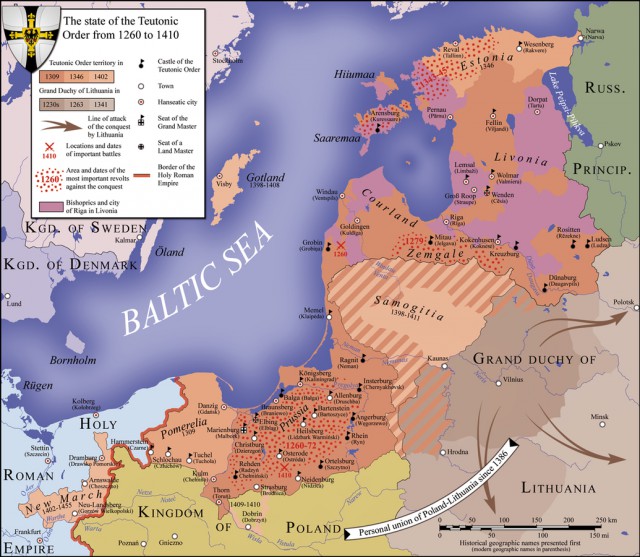
In addition, the Teutonic knights hired many thousands of men-at-arms to fulfill lighter roles and some heavy infantry. As they were essentially conducting one long crusade, they Teutonics were often joined by guest crusaders, nobles who sought to prove their piety and martial prowess by temporarily joining the cause. These nobles often brought sizeable contingents of their own men as well.
The push towards the titanic battle of Tannenburg started with the unification of Poland and Lithuania by the marriage of Jadwiga of Poland to Jagiello of Lithuania. Jagiello’s cousin, Vytautas, sought power for himself and negotiated with the Teutonics for support. Jagiello and Vytautas eventually reconciled, and Vytautas was given the title of grand prince.
The initial overture to the Teutonics was enough to raise tensions between the two powers. Lithuania and Poland had actually officially declared Christianity as the official religion. However, there was still much animosity as the Teutonics believed this to be a hollow declaration as many of the people remained pagan or Orthodox Christians.
As tensions reached a boiling point the joint armies of Poland and Lithuania came together to invade Teutonic lands with goals of reclaim lost and disputed land. The Grand Master of the Teutonics, Ulrich von Jungingen was prepared for the invasion and quickly organized a large army. The two forces met near the villages of Tannenberg and Grunwald on July 15th.
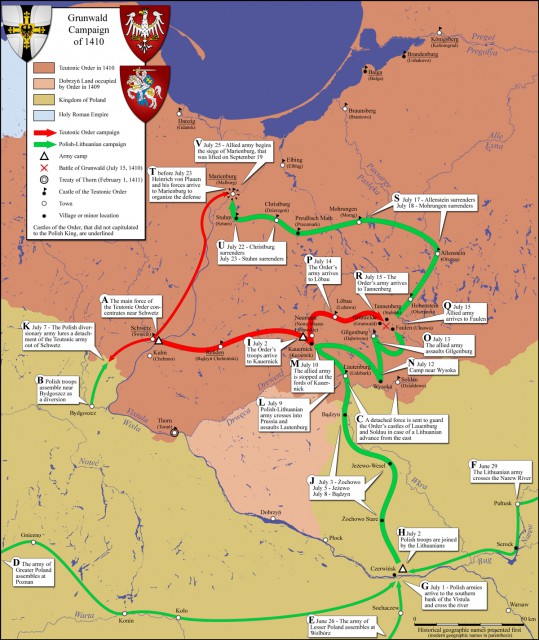
Precise numbers of forces are very difficult to ascertain, but it seems that the Teutonic order had 20-30,000 forces including several hundred heavy knights between them and the guest crusaders. The combined Polish and Lithuanian forces fielded a larger, but an overall lighter force of around 25-40,000. Prior to the battle, the Teutonic Grand Master sent two swords to King Jagiello and Prince Vytautas to “assist them in battle” a harsh insult to the leaders and an invitation of battle.
The armies lined up facing each other with equal frontage as the hot sun glimmered off of the heavy armor. The two sides charged straight forward in a whirl of color as hundreds of national and individual standards and banners flew all over the battlefield.
The Poles held the left while the Lithuanians held the right against the guest crusaders. The sides were locked for as long as two hours before the Lithuanians began a full retreat. They were pursued by the guest crusaders as far as the baggage trains where the crusaders stopped to loot.
On the Polish left their exposed center was flanked, and King Jagiello was exposed. The battle was fierce as groups from either sided forced their way towards recognizable banners. The capture or fall of a banner during the battle had a major impact on morale and bearers fought to the death to maintain raised banners.
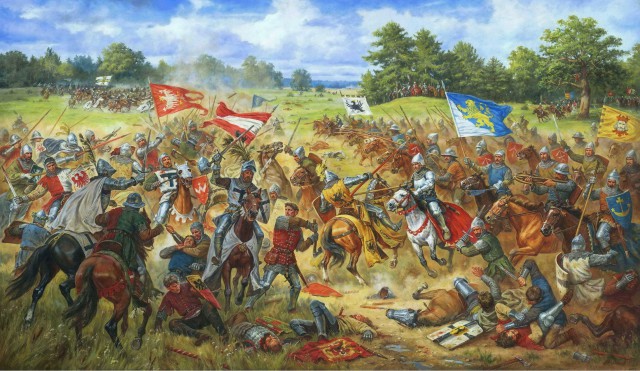
In a very Alexandrian effort to target the king, Ulrich took a large force of the heaviest Teutonic knights and dove through the exposed gap towards King Jagiello. Prince Vytautas, who had been part of the retreating Lithuanians, saw this attack and led his own heavy cavalry to intercept just as Ulrich’s forces collided with the King’s guard.
A grueling battle ensued as the most elite and well-armored forces in Eastern Europe fought their own battle surrounded by the much larger battle. the Teutonic charge was halted within sight of King Jagiello, but one Teutonic knight was able to charge directly at the king. The king was saved by a young secretary, Zbigniew Olesnicki, who would eventually become one of the most influential men in Poland.
With the battle in a stalemate, the routed Lithuanians returned to the battlefield. It is heavily debated as to whether or not the rout was a planned maneuver. On one hand, the Lithuanians returned in good order and won the day by capitalizing on disorganized Teutonic forces. On the other hand, the Lithuanians were out of the battle for much longer than they should have been if they originally planned a false retreat.
Regardless of being planned or not, the return of the Lithuanians pushed back the already scattered guest crusaders and trapped the stalled charge of Ulrich. Ulrich along with nearly all of the ranking members of the Teutonic order were killed and many elite knights were captured.
The remaining Teutonic forces put up a fight, but eventually collapsed unit by unit into a full retreat. Remaining Teutonic knights and laybrothers formed a wagon fort and tried to defend their camp. The improvised fort was soon broken and many more casualties followed.
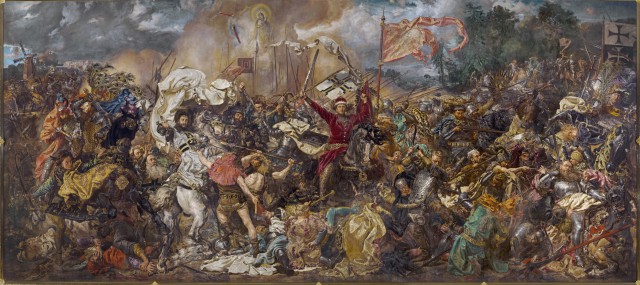
The total victory was a huge blow to Teutonic power in Europe as hundreds of prominent members were killed and large amounts of land seized. The combined Lithuanian and Polish forces could not capture the main fortress of Marienburg, but took several surrounding castles. Eventually, a peace was negotiated and the Teutonic order was forced to pay war reparations.
The victory reversed a longstanding and aggressive campaign against nations that were slowly converting to Christianity on their own, King Jagiello and Queen Jadwiga were devout Catholics who made strong efforts to convert their own nations.
The victory is still a major symbol of national pride; the two swords insultingly given to the king and prince became symbols of victory and adorned the medals of valor given for bravery in the fight against Germany in WWII.
The Teutonic order actually survived and has adapted to modern times to be a purely religious and charitable organization.
By William McLaughlin for War History Online
